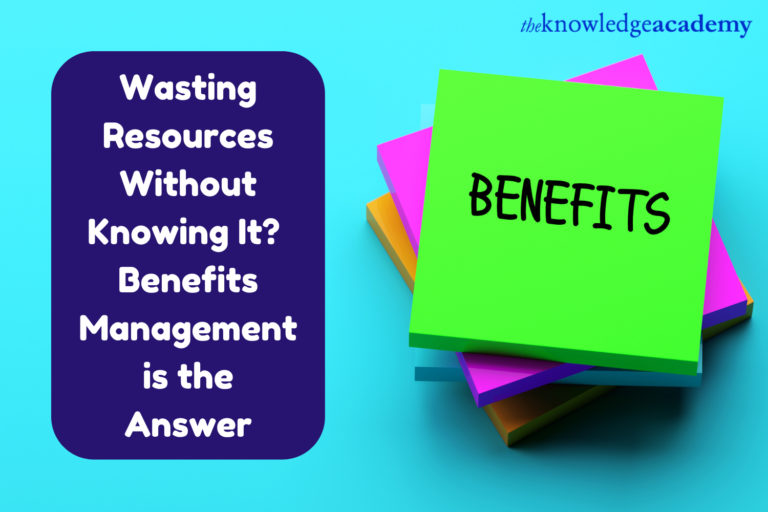Every year, how much money, time, and effort does your company squander on initiatives that don’t add value? If your organisation is aggressively spending but sees no appreciable outcomes, Managing Benefits Certification is for you. It equips experts with the tools to recognise, monitor, and maximise corporate benefits, ensuring that every project contributes to long-term success.
Benefits Management—a disciplined approach to cutting waste, boosting efficiency, and aligning investments with strategic goals—is at the core of this strategy. Let’s explore how implementing benefits management can help your organisation unlock its full potential and drive better results.
Menu list
Signs You Are Wasting Resources Without Realising It
Resource waste often goes unnoticed until it impacts company performance. Here are some common signs your company might be losing valuable assets:
- Projects without Clearly Defined Results: If your projects lack clearly defined benefits, you could be funding programmes that fail to support corporate success.
- Teams Working on Related Goals without Alignment: This leads to repeated work and inefficiency.
- Unchecked Budget Spending: It’s essential to review if your spending aligns with predicted benefits, especially if costs keep rising without a reasonable explanation.
- Ignoring Results from Investments in Resources: Failing to track results means missing opportunities for maximum efficiency.
- Low Stakeholder Satisfaction: Projects failing to deliver value to stakeholders could highlight a gap between strategy and execution.
Businesses risk falling into the trap of reactive decision-making and spending on initiatives without a long-term vision or a method to measure performance, all without an appropriate benefits management system.
How Benefits Management Helps You Maximise Value
A benefits management system ensures that every decision and investment advances long-term success. It facilitates the following:
- Enhanced Decision Making: Identifying and prioritising key benefits helps companies make wise decisions aligned with corporate objectives.
- A Methodical Approach to Benefits Realisation: Guides resources to where they will have the most impact.
- Improved Accountability: Teams that understand the expected outcomes become more focused.
- Measurable Success: With well-defined key performance indicators (KPIs), companies can track progress and ensure they’re on the right course.
- Building Confidence: Demonstrating real benefits helps internal teams, clients, and investors feel more confident.
- Long-term Benefits Realisation: Guarantees companies to stay competitive and continuously improve their operational methods.
Companies that embrace benefits management reduce waste and turn inefficiencies into opportunities that provide them with a competitive edge in their sectors.
Key Steps to Implementing Benefits Management Effectively
Achieving accurate results depends on using a methodical approach to benefits management. Here is a guide to applying it successfully:
- Clearly Define Objectives: First, determine why each project is being undertaken. Create SMART—specific, measurable, achievable, relevant, and time-bound—benefits to ensure direction and clarity. Well-defined benefits help teams see how their activities support corporate goals.
- Align with Corporate Strategy: Ensure every project and budget allocation supports main corporate objectives. This prevents wasted effort and misalignment. Good alignment guarantees that every investment contributes to the company’s larger goal, thus reducing unnecessary costs.
- Create a Benefits Realisation Strategy: List the times and ways benefits will be realised. This includes defining success criteria, assigning tasks, and establishing key milestones. A well-organised strategy ensures that each project participant knows their role in delivering value.
- Track Progress and Adapt: Monitor performance using KPIs and benefits tracking systems. Adjust plans if progress differs from expected results. Regular performance reviews help companies make necessary changes and ensure that expected benefits are being realised.
- Engage Participants: Engaging key stakeholders ensures accountability and transparency. Feedback loops and regular updates help keep everyone aligned. Understanding the value being delivered encourages stakeholders to support and contribute to the project’s success.
Conclusion
Benefits management is the key to reversing the trend if your company is unintentionally wasting money. Organisations can maximise efficiency and deliver actual value by focusing on clearly stated goals, tracking progress, and optimising resource use. A well-organised benefits management system ensures that companies don’t just carry out initiatives but do so with intention, effectiveness, and measurable results.
A certification in benefits management from The Knowledge Academy can help you advance your career.




